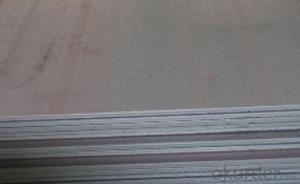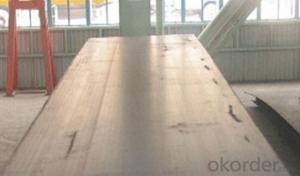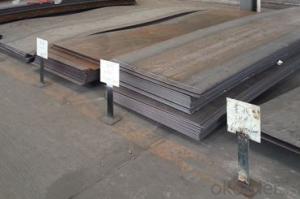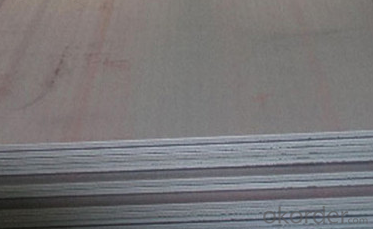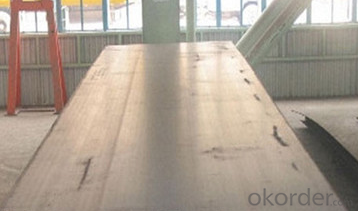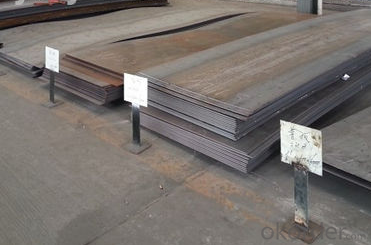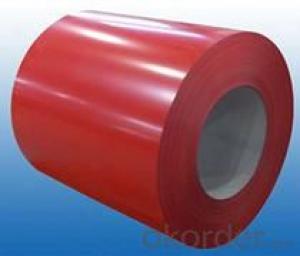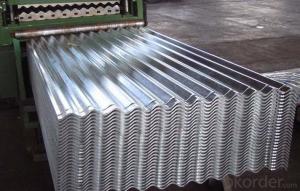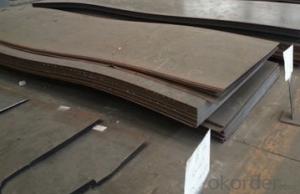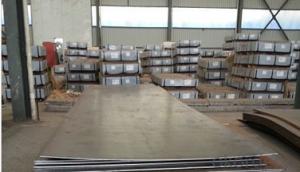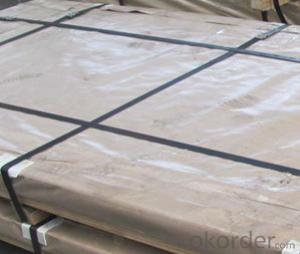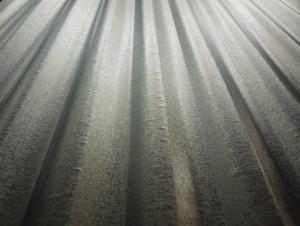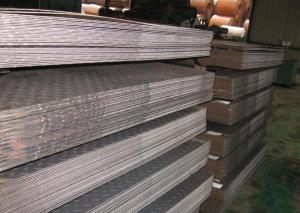Hot Rolled Carbon Steel Sheet A678 CNBM
- Loading Port:
- Qingdao
- Payment Terms:
- TT OR LC
- Min Order Qty:
- 10 pc
- Supply Capability:
- 30 pc/month
OKorder Service Pledge
Quality Product, Order Online Tracking, Timely Delivery
OKorder Financial Service
Credit Rating, Credit Services, Credit Purchasing
You Might Also Like
Quick Details
| Standard: | AISI, ASTM, DIN, GB, JIS | Grade: | A572,A573,A633,A678,A709,A710,G3101,G3136,etc | Thickness: | 1mm-200mm |
| Brand Name: | SHOU GANG GROUP, AN STEEL | Model Number: | Q235 | ||
| Type: | Steel Plate | Technique: | Hot Rolled | Surface Treatment: | Coated |
| Application: | widely | Special Use: | High-strength Steel Plate | Width: | 1000mm-3000mm |
| Length: | 1000mm-12000mm | Price Term: | FOB CIF CFR |
Packaging & Delivery
| Packaging Details: | standard seaworthy export packing or as the request of customers |
| Delivery Detail: | 10 days after deposit or according to customers' quantity |
Specifications
hot rolled carbon steel sheet
1.Thickness:1mm-200mm
2.Length:1000mm-12000mm
3.Width:1000mm-2000mm
hot rolled carbon steel sheet
| Product | HR steel plate prices carbon steel plate prices per kg |
| MOQ | 25 ton |
| Thickness | 1mm-200mm |
| Width | 1000mm-3000mm |
| Length | 1000mm-12000mm |
| Application | widely |
| Standard | AISI,ASTM,BS,DIN,JIS,GB,etc |
| Grade | A572,A573,A633,A678,A709,A710,G3101,G3136,etc |
| Tpye | Steel plate |
| Surfacing | Coated |
| Productive Technology | Hot Rolled & Cold Rolled |
| Port | |
| Payment Terms | L/C,T/T,Western Union,MoneyGram |
| Product Ability | 5000 tons per month |
| Delivery | 10 days after deposit or according to customers' quantity |
| Packing | standard seaworthy export packing or as the request of customers |
- Q: What does "rolled steel" mean?.
- Generally refers to the thickness below 3, some enterprises have used rolling process, for example, 1.97 of the stainless steel materials market is difficult to buy, the enterprise will use 2 or 2.5 of the material rolling process processing, production of 1.97 thickness.
- Q: What is the process of applying anti-fingerprint coatings to steel sheets?
- The process of applying anti-fingerprint coatings to steel sheets typically involves several steps. First, the steel sheets are thoroughly cleaned to ensure there is no dirt, grease, or any other contaminants on the surface. This cleaning process may involve using solvents or chemical cleaners. Once the sheets are clean, a primer or base coat is applied to enhance adhesion of the anti-fingerprint coating. The primer is usually a thin layer that helps the subsequent coating adhere to the steel surface more effectively. After the primer has dried, the anti-fingerprint coating is applied. This coating is specifically designed to repel fingerprints, smudges, and other marks that can easily appear on steel surfaces. The coating is typically sprayed or rolled onto the steel sheets in a controlled environment to achieve a uniform and consistent coverage. Once the coating is applied, the steel sheets are usually cured or dried at specific temperature and time conditions to ensure proper bonding and durability of the anti-fingerprint coating. This curing process helps the coating to fully harden and form a protective layer on the steel surface. Overall, the process of applying anti-fingerprint coatings to steel sheets involves surface cleaning, primer application, anti-fingerprint coating application, and curing to achieve a durable and effective protective layer.
- Q: Can steel sheets be used for automotive chassis?
- Yes, steel sheets can be used for automotive chassis. Steel is a common material used in the construction of automotive chassis due to its high strength, durability, and cost-effectiveness. It provides the necessary structural integrity and rigidity required to support the vehicle's weight and withstand various stresses and impacts.
- Q: How do steel sheets perform in terms of thermal conductivity?
- Steel sheets have a relatively high thermal conductivity, meaning they efficiently transfer heat.
- Q: What is the process of applying fire-resistant coatings to steel sheets?
- The process of applying fire-resistant coatings to steel sheets usually involves cleaning and preparing the surface of the steel sheets to ensure optimal adhesion. Then, a fire-resistant coating is applied using techniques such as spraying, rolling, or brushing. The coating is left to dry or cure, depending on the specific product, and may require multiple coats for desired protection. The coated steel sheets are then ready to be used in applications where fire resistance is required.
- Q: What are the different standards and certifications for steel sheets?
- Steel sheets must adhere to numerous standards and certifications in order to ensure their quality and compliance with industry requirements. Some of the well-known ones are: 1. ASTM International: To establish the mechanical and chemical properties of steel sheets, ASTM A1008/A1008M provides a standard specification for cold-rolled, carbon, structural, high-strength low-alloy steel sheets with improved formability. 2. American Iron and Steel Institute (AISI): Various standards are offered by AISI for different types of steel sheets, such as AISI 4130, AISI 4140, AISI 4340, etc. These standards outline the chemical composition, mechanical properties, and heat treatment requirements for specific steel sheet types. 3. International Organization for Standardization (ISO): ISO has developed standards like ISO 3574, ISO 630, and ISO 4998 to cover dimensional tolerances, mechanical properties, and technical delivery conditions for specific steel sheet grades. 4. European Committee for Standardization (CEN): CEN has defined requirements for cold-rolled, hot-rolled, and high-strength steel sheets through standards like EN 10130, EN 10025, and EN 10149 respectively. These standards encompass aspects such as chemical composition, mechanical properties, and surface finish. 5. Japan Industrial Standards (JIS): JIS standards like JIS G 3141, JIS G 3131, and JIS G 3132 are widely used for cold-rolled, hot-rolled, and hot-rolled high-strength steel sheets respectively. They specify the mechanical properties, chemical composition, and dimensional tolerances of steel sheets. Furthermore, steel sheet manufacturers can obtain various certifications to demonstrate their adherence to specific quality and environmental management systems. Some widely recognized certifications in the steel industry include ISO 9001 (Quality Management System), ISO 14001 (Environmental Management System), and OHSAS 18001 (Occupational Health and Safety Management System). These certifications guarantee that manufacturing processes and products meet the required standards while being produced in an environmentally sustainable and safe manner.
- Q: What are the different surface patterns available for steel sheets?
- There are several different surface patterns available for steel sheets, including smooth, diamond, stucco, and textured patterns.
- Q: What is the difference between stainless steel and regular steel sheets?
- Stainless steel and regular steel sheets differ primarily in their composition and properties. Stainless steel is an alloy made from a combination of iron, chromium, and other elements such as nickel and molybdenum. Regular steel, on the other hand, is primarily composed of iron with small amounts of carbon and other impurities. The key difference between stainless steel and regular steel sheets lies in their corrosion resistance. Stainless steel is highly resistant to corrosion due to the presence of chromium, which forms a protective layer on its surface when exposed to oxygen. This layer, known as a passive film, prevents the steel from rusting and makes it suitable for applications in environments with high moisture or chemical exposure. Regular steel sheets, on the other hand, are prone to corrosion as they lack the protective chromium layer. They may require additional coatings or treatments to enhance their corrosion resistance. Without proper protection, regular steel sheets can rust and deteriorate over time when exposed to moisture or corrosive substances. Another difference between stainless steel and regular steel sheets is their strength and hardness. Stainless steel is generally stronger and more durable than regular steel due to its alloy composition. It can withstand higher temperatures and has better resistance to wear and tear. Regular steel, although strong, may not offer the same level of strength and durability as stainless steel. The aesthetic appeal is another contrasting factor between the two. Stainless steel sheets have a shiny, reflective surface that gives them a modern and sleek appearance. They are often used in architectural and decorative applications where visual appeal is desired. Regular steel sheets, on the other hand, have a more dull and matte finish and are primarily used for structural and industrial purposes rather than for their visual appeal. In summary, stainless steel sheets offer superior corrosion resistance, strength, and aesthetic appeal compared to regular steel sheets. They are a preferred choice for applications where durability, hygiene, and maintenance-free performance are required, such as in kitchens, medical equipment, automotive parts, and construction projects. Regular steel sheets, while less expensive, may require additional protection and are commonly used in structural and industrial applications where corrosion resistance and visual appeal are not primary concerns.
- Q: Are steel sheets suitable for playground equipment?
- Indeed, playground equipment can be made using steel sheets. Steel is a robust and enduring substance that can endure extensive use, offering a secure playing environment for children. Steel sheets are versatile and can be utilized to build an array of playground equipment, ranging from slides to climbing structures and swing sets. Moreover, steel is impervious to weather conditions, rendering it an ideal selection for outdoor playgrounds. The material can be effortlessly molded and formed into various designs, providing room for innovation and personalization in playground equipment. All in all, steel sheets are a dependable and enduring choice for playground equipment, guaranteeing children's safety and enjoyment.
- Q: Are steel sheets resistant to termites?
- No, steel sheets are not resistant to termites.
Send your message to us
Hot Rolled Carbon Steel Sheet A678 CNBM
- Loading Port:
- Qingdao
- Payment Terms:
- TT OR LC
- Min Order Qty:
- 10 pc
- Supply Capability:
- 30 pc/month
OKorder Service Pledge
Quality Product, Order Online Tracking, Timely Delivery
OKorder Financial Service
Credit Rating, Credit Services, Credit Purchasing
Similar products
Hot products
Hot Searches
Related keywords
